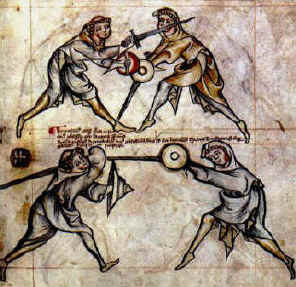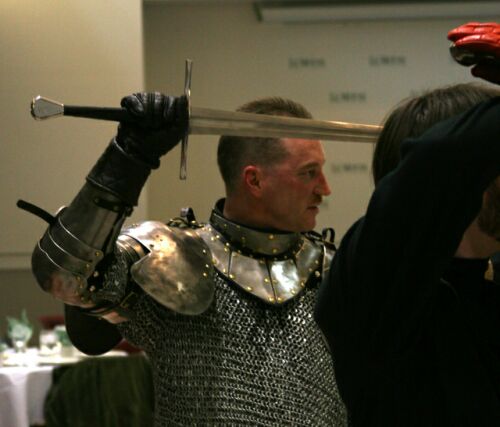You are using an out of date browser. It may not display this or other websites correctly.
You should upgrade or use an alternative browser.
You should upgrade or use an alternative browser.
Fighting Medieval Style
- Thread starter heirodule
- Start date
CharlesRyan
Adventurer
Cool, but definitely Rennaissance (not Medieval).
Huw
First Post
Nice 
I've got Hans Talhoffer's Fechtbuch from 1467, translated into English as "Medieval Combat".
Illustrations from an earlier edition can be seen at Talhoffer's Fechtbuch - 1459 Edition.
I've got Hans Talhoffer's Fechtbuch from 1467, translated into English as "Medieval Combat".
Illustrations from an earlier edition can be seen at Talhoffer's Fechtbuch - 1459 Edition.
Ydars
Explorer
Me too Huw!
For other Fechtbuchs, try Christian Tobler's translations of Master Lictenauer's sword techniques. I so love some of them, like cutting from Von Tag so that a parry becomes a simultaenous attack.
Then there is Fiore De Liberi's "Fiore di Battaga" which is probably the most complete medieval Fechtbuch I have seen, covering unarmed, dagger, sword and polearms. Bob Charron has a good translation but I am not sure if he has published it yet.
Even went to a course once on techniques from De Liberi and some of the plays for disarming are awesome. I can still do one that completely disarms someone wielding a longsword, as long as you can get in close.
For other Fechtbuchs, try Christian Tobler's translations of Master Lictenauer's sword techniques. I so love some of them, like cutting from Von Tag so that a parry becomes a simultaenous attack.
Then there is Fiore De Liberi's "Fiore di Battaga" which is probably the most complete medieval Fechtbuch I have seen, covering unarmed, dagger, sword and polearms. Bob Charron has a good translation but I am not sure if he has published it yet.
Even went to a course once on techniques from De Liberi and some of the plays for disarming are awesome. I can still do one that completely disarms someone wielding a longsword, as long as you can get in close.
Galloglaich
First Post
Cool, but definitely Rennaissance (not Medieval).
True, though it's worth remembering these fechtbuchs are part of a tradition which goes back at least to the anonymous I.33 manual, which is 13th Century

In case some pepole wanted to see what drill and sparring with these systems looks like, there is a modern revival of these martial arts going on right now (since about 1998 when Sydney Anglo Published The Martial Arts of Renaissance Europe, which kind of brought these old books back into the public eye... many of them have been translated now from latin or various archaic dialects and there are probably 30 or 40 large HEMA groups around the world who do Medieval / Renaissance European Martial Arts, including in the US, Europe, China, Australia, South Africa, Singaporee and the Philipines.
Here are some drill videos
[ame=http://www.youtube.com/watch?v=5YQP6lthpLA&feature=channel]YouTube - Longsword some techniques II[/ame]
[ame=http://www.youtube.com/watch?v=Kj4Ng6DBfrg&feature=related]YouTube - Fechten mit dem langen Schwert[/ame]
[ame=http://www.youtube.com/watch?v=38sVdx7nzhQ&feature=related]YouTube - Langes Messer[/ame]
and here are some sparring vids
[ame=http://www.youtube.com/watch?v=mPkX_oF3pZE&feature=channel_page]YouTube - Like Steel Wasters Demonstration II[/ame]
[ame=http://www.youtube.com/watch?v=EUTVO8N4aqA&feature=channel_page]YouTube - Stew Feil's Prize Playing 2007[/ame]
[ame=http://www.youtube.com/watch?v=qUWMr-kYouk]YouTube - Longsword fencing sparring at GHFS[/ame]
http://www.thearma.org/essays/SandB/I33.jpg
Cool, but definitely Rennaissance (not Medieval).
Yes. And note that the presence (and type) of armor has a major impact on fighting style.
Galloglaich
First Post
Yes. And note that the presence (and type) of armor has a major impact on fighting style.
In Lichtenauer tradition German Renaissance fencing there are two recognized types of fighting:
Blossfechten, which means unarmored fighting, and
Harnischfechten, which means fully armored fighting (literally fighting in Harness).
Unlike in DnD, in the real world plate or even mail armor were basically impervious to sword cuts. So the Harnischfechten fencing emphasizes half-swording (gripping the blade)

and ringen (the German Renaissance equivalent to Jujitsu).

Harnichfechten is fairly simple: it boils down to fighting at the half-sword, using ringen or ringen am-schwert (jujitsu while using the sword for leverage) to take your opponent down, and then make use of powerful half-sword thrusting attacks to finish them off...

...or using the pommel or quillions of your sword like a mace using the Mortschlag ('murder stroke')

Quite often harnischfechten fights would end up finished with daggers. Judicial combat among the aristocracy would often be fought in full armor, commoners usually fought in street clothes or sometimes partial armor (or special leather suits). In many cases these fights were not to the death, but if they were the dagger often had the last word.

There was also a considerable amount of attention in many manuals paid to specialized weapons like Poll Axes and military picks which were designed to puncture armor.
Blossfechten is the more sophisticated fencing system, and would also include fighting in light armor or partial armor. If your opponent was wearing a mail shirt for example, you cut somewhere else. Excavations of major medieval / Renaissance battlefields like Wisby show that most of the skeletons with signs of battle damage recieved wounds where there was no armor- primarily the lower legs. A few skeletons had both legs severed, apparently by the same cut.
In many of the Italian fencing manuals and in their surviving legal dueling codes it is recommended to check both combattants before a duel or judicial combat to make sure they aren't wearing mail (armor) under their clothing, or carrying any magical charms
G.
Last edited:
Similar Threads
- Replies
- 3
- Views
- 4K
- Replies
- 0
- Views
- 5K
- Replies
- 300
- Views
- 31K
